
Poll shows 83 percent of Republicans still support the president, but they are increasingly isolated.
President Donald Trump’s approval rating has fallen to just 40 percent, the lowest since his return to the White House, according to a new Reuters/Ipsos poll. Reuters said the survey reflected dissatisfaction with Trump’s handling of the economy and immigration and showed how “deeply polarized” the nation is over his leadership. According to the poll, 83 percent of Republicans approve of Trump’s performance compared to just 3 percent of Democrats. Meanwhile, only around a third of independents said they supported the president. The poll, conducted over three days to Monday, surveyed 1,023 adults and had a margin of error of 3 percentage points. The dip in Trump’s approval rating comes as his administration continues to pursue aggressive policies on trade and border security, despite widespread opposition. Trump’s previous rating stood at 41 percent in mid-July.

Trump issues order imposing new global tariff rates effective Aug. 7
The executive order follows through on the president’s recent trade agreements with some trading partners and his threats to slap punishing new duties on others.
President Donald Trump signed executive orders on Thursday evening to impose tariffs of between 15 and 41 percent on goods shipped to the U.S. from more than 67 countries, ratcheting up tariffs to the highest levels in more than a century.
The new duties, however, won’t go into effect until Aug. 7 — giving countries yet another window to try to negotiate them down.
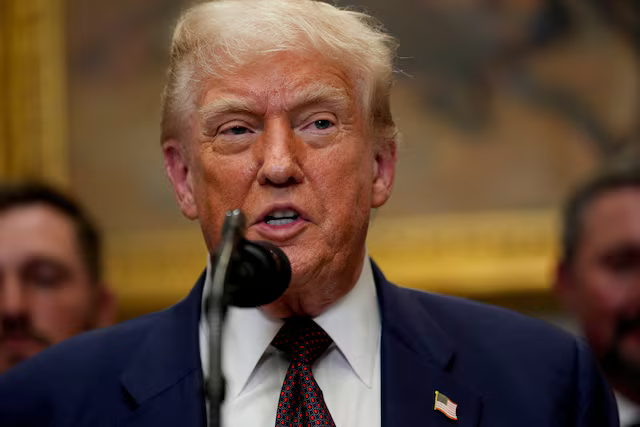
“This is historic, this is a new system of trade,” said a senior administration official, granted anonymity as part of the terms of a call. “It’s what I would call the Trump round of negotiations.”
According to the text of the first order, the Trump administration is maintaining its 10 percent so-called baseline tariff on countries where the U.S. has a trade surplus — i.e. it sells more American products to those countries than it imports from them. And it officially imposes the 15 percent rate that Trump agreed to set as part of negotiations with leading trading partners like the European Union, Japan and South Korea. The Philippines, Vietnam and Indonesia also reached tentative agreements with the administration that set their duties at 19-20 percent.
Other countries, mainly smaller economies, face far higher rates, topping out at 41 percent for Syria, which is emerging from a civil war, and 40 percent for Myanmar, which is still in the midst of one. The Southeast Asian nation of Laos also faces a 40 percent tariff, and Iraq will be hit with a 35 percent duty.
Bigger trading partners like Switzerland also face a significant tariff hike — to 39 percent.
Trump also signed a second order raising tariffs on Canada, one of the country’s biggest trading partners, from 25 to 35 percent for goods that are not compliant with an existing North American trade deal known as the U.S.-Mexico-Canada Agreement. The senior official told reporters that Canada hasn’t “shown the same level of constructiveness that we’ve seen from the Mexican side.” Trump announced earlier Thursday that he was maintaining the 25 percent tariff on Mexico for another 90 days after a phone call with their president, Claudia Sheinbaum. Higher tariffs on Canada take effect Friday.
The executive actions suggests that Trump decided to punish countries that he did not believe offered enough concessions since the president first threatened to impose his “reciprocal” tariffs on April 2.
“Some trading partners have agreed to, or are on the verge of agreeing to, meaningful trade and security commitments with the United States, thus signaling their sincere intentions to permanently remedy the trade barriers,” the global order says.
“Other trading partners, despite having engaged in negotiations, have offered terms that, in my judgment, do not sufficiently address imbalances in our trading relationship or have failed to align sufficiently with the United States on economic and national-security matters,”
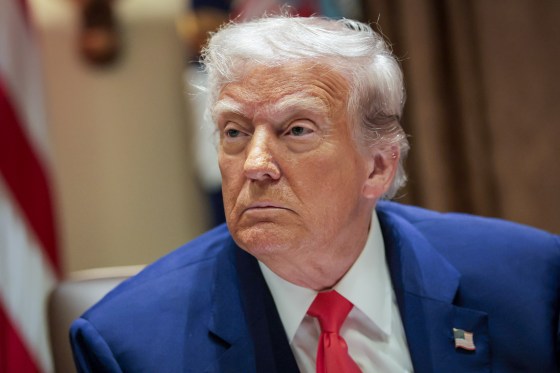
“There are also some trading partners that have failed to engage in negotiations with the United States or to take adequate steps to align sufficiently with the United States on economic and national security matters,” it continues.
White House officials said Thursday night that they expect to strike additional agreements with countries ahead of the new Aug. 7 implementation date for the tariffs. “We have some deals, and I don’t want to get ahead of the president on those deals,” the senior administration official told reporters. “I’ll just say generally, we have more to come.”
Taiwan is hoping to be one of those countries. The semiconductor powerhouse faces a 20 percent tariff in a week’s time, but in a statement released late Thursday, Taiwanese President Lai Ching-te suggested the rate was “provisional.”
“Due to the procedural arrangement of the negotiations, the Taiwan-U.S. sides have not yet concluded the final meeting. Therefore, the U.S. has temporarily announced a 20% tariff rate for Taiwan,” President Lai said. “Once an agreement is reached in the future, there is hope that the tariff rate can be further lowered. Both sides will also continue negotiations on supply chain cooperation and issues related to Section 232 tariffs.”
Raging Trump Orders Top Republican to Stop Letting Democrats Laugh at Him

Donald Trump has demanded that Senate Judiciary Chair Chuck Grassley scrap a “ridiculous” tradition that allows home-state senators to block judicial nominees.
The president posted that Democrats will exploit it to “laugh” at Grassley and the Republicans.
In a lengthy tirade on Truth Social, Trump urged Grassley to eliminate the so-called “blue slip” custom, a decades-old Senate tradition that gives senators from a nominee’s home state the chance to object to federal judicial nominations.

Trump argued that Democrats will abuse the process, which is meant to encourage bipartisan consultation, to obstruct his picks for key judicial positions with nothing more than “a mere flick of the pen.”
“Senator Grassley must step up, like Crooked Joe Biden did, when he openly broke, at least two times, the ‘Blue Slip’ SCAM, and like others have done over the years, and let our Great Republican Judges and U.S. Attorneys BE CONFIRMED,” Trump wrote.
“He should do this, IMMEDIATELY, and not let the Democrats laugh at him and the Republican Party for being weak and ineffective. The Democrats have broken this ridiculous custom on us, it’s time that we break it on them. Chuck, I know you have the Courage to do this, DO IT!”
The custom is named after the blue-colored form sent to senators seeking their approval or disapproval.
A spokesperson for Grassley, while not directly answering Trump’s new demand, noted that the Senate Judiciary chair had already successfully moved Trump’s picks for U.S. attorneys through his panel with blue slip support from Democratic senators such as Tim Kaine and Mark Warner in Virginia and Minnesota’s Amy Klobuchar and Tina Smith.
“When a nominee comes out of committee all 100 senators have a say on the nomination and part of their consideration is based on the home state senators’ input,” the spokesperson told the Daily Beast.

Speaking to Politico, the 91-year-old Grassley added he has no intention of changing his approach to sending out blue slips for federal court nominees.
“I’ve already spoken about the blue slip problem. And I’ve got no more to say than what I’ve been saying for 50 years,” he said.
How Trump’s tariffs are already impacting Americans
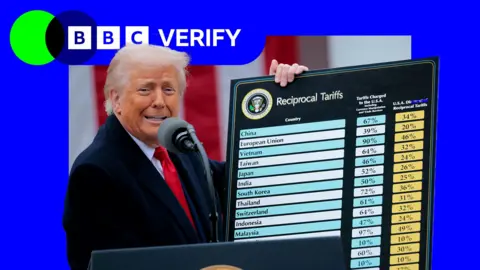
Donald Trump has delivered a profound shock to the global trading system since returning to the White House.
The US president announced on 2 April, so-called Liberation Day, a slew of swingeing so-called “reciprocal” tariffs, or import taxes, hitting dozens of countries around the world.
Many of these have been paused. And since then, Trump has also announced agreements with several partners – including the UK, Vietnam, Japan, and the European Union – which reduce some tariff levels.
But particular commodities and goods such as automobiles and steel have also been targeted with significant industry-specific tariffs by Washington – and the overall average US tariff rate is at its highest in almost a century.
The tariffs themselves are ultimately paid by the US companies that bring goods into the country from abroad.
The impact of all this is being felt in the US and global economy in different ways.

More tariff revenue for the US government
The Budget Lab at Yale University estimates that, as of 28 July 2025, the average effective tariff rate imposed by the US on goods imports stood at 18.2%, the highest since 1934.
That was up from 2.4% in 2024, before Donald Trump returned to office.
That significant increase means the US government’s tariff revenues have shot up.
Official US data shows that in June 2025 tariff revenues were $28bn, triple the monthly revenues seen in 2024.
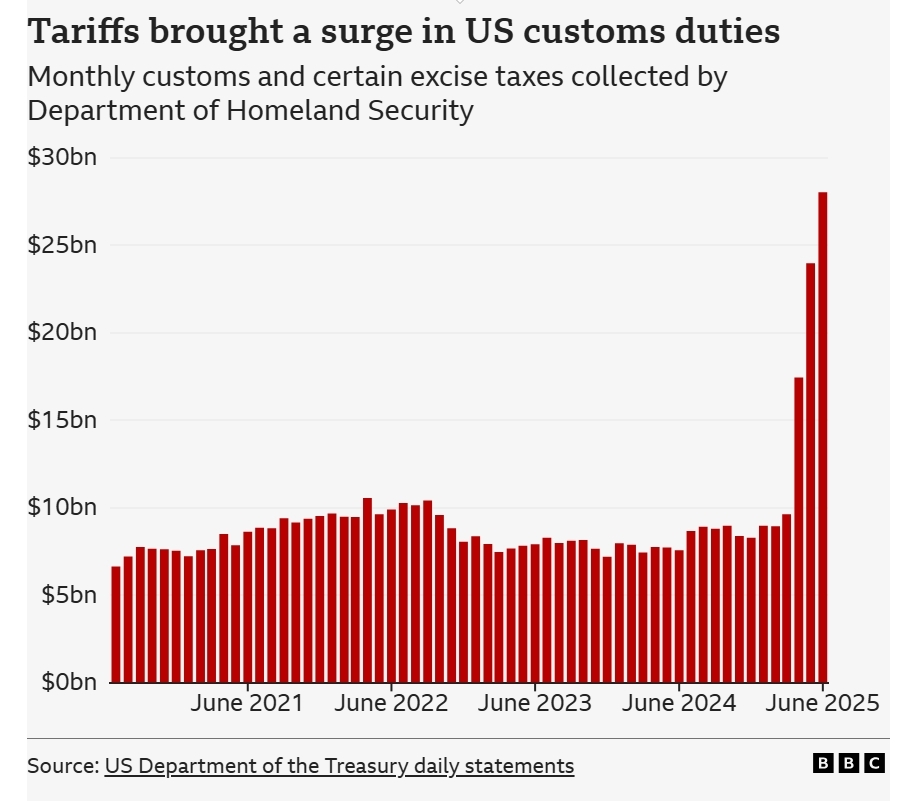
The Congressional Budget Office (CBO), the independent US fiscal watchdog, estimated in June that the increase in tariff revenue, based on the new US tariffs imposed between 6 January and 13 May 2025, would reduce cumulative US government borrowing in the 10 years to 2035 by $2.5 trillion.
However, the CBO also judged that the tariffs would shrink the size of the US economy relative to how it would perform without them.
They also project that the additional revenues generated from the tariffs will be more than offset by the revenue lost due to the Trump administration’s tax cuts over the next decade.
A widening of the US trade deficit
Donald Trump regards bilateral trade deficits as evidence that other countries are taking advantage of the US by selling more goods to America than they buy from it.
One of the justifications for his tariffs is to address that imbalance by curbing imports and forcing other countries to lower their own barriers to US goods.
However, one of the standout impacts of Donald Trump’s trade war, so far, has been to increase US goods imports.
This is because US firms stockpiled supplies in advance of tariffs being implemented to avoid being forced to pay the additional tax.
Meanwhile, US exports have seen only a modest increase.
The net result is that the US goods trade deficit has widened, not fallen.
It reached a record $162bn in March 2025, before falling back to $86bn in June.
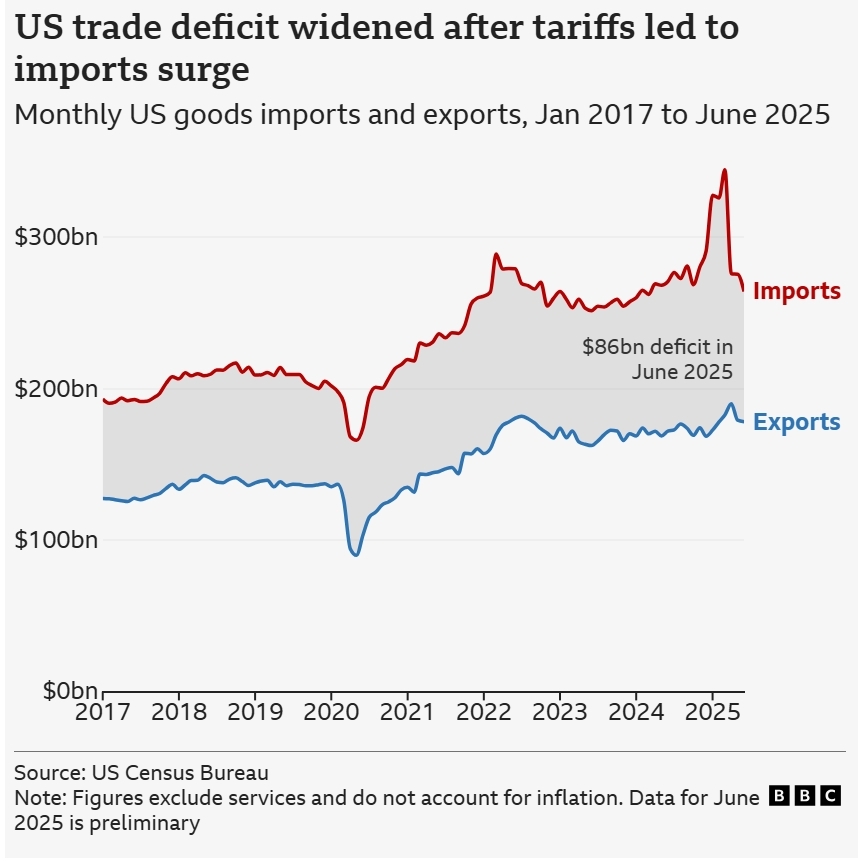
The distortion caused by stockpiling will fade, but over the longer term many economists expect the Trump administration will still struggle to bring down the overall US trade deficit.
That’s because they argue that the deficit is primarily driven by structural imbalances within the US economy – persistent national spending in excess of national production – rather than unfair trade practices directed at America by other nations.
China is exporting less to America
Trump imposed punitive tariffs on China, with levies at one stage hitting 145%.
They have come down to 30% but the impact of those trade hostilities on Chinese trade with America has nevertheless been significant.
The value of Chinese exports to the US in the first six months of 2025 were down 11% on the same period in 2024.
Meanwhile, Chinese exports to some of its other trading partners have grown, suggesting Chinese firms have been able to find customers in other countries.
China’s exports to India this year are up 14% on the same period last year and with the EU and the UK they are up 7% and 8% respectively.
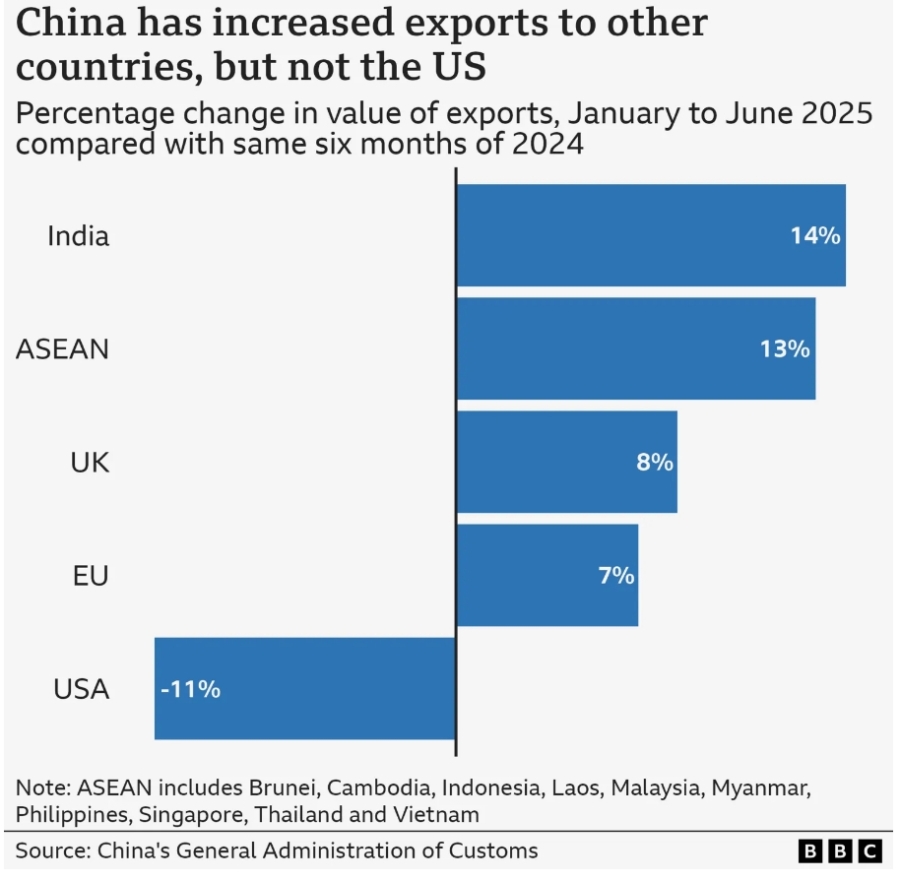
Also notable is a 13% increase in the value of Chinese exports to the ASEAN nations, which include Vietnam, Thailand, Indonesia and Malaysia, over that period.
The Trump administration has been concerned about the possibility of Chinese firms attempting to bypass US tariffs on China by setting up operations in neighbouring South East Asian countries – to which they export semi-finished goods – and exporting finished goods to the US from there.
Such “tariff jumping” occurred when Donald Trump imposed tariffs on Chinese solar panels in his first term and some economists argue the increase in Chinese exports to ASEAN nations could be related to the same phenomenon.

More trade deals
Some countries have responded to Trump’s trade war by seeking to deepen trade ties with other countries, rather than by putting up their own barriers.
The UK and India have signed a trade deal that they were negotiating for three years.
Norway, Iceland, Switzerland and Liechtenstein – who are in a grouping called the European Free Trade Association (EFTA) – have concluded a new trade deal with a number of Latin American countries in a grouping known as Mercosur.
The EU is pushing ahead with a new trade deal with Indonesia.
Canada is exploring a free trade agreement with ASEAN.
Some countries have also taken advantage of the fracturing of trade between the US and China.
China has traditionally been a significant global importer of soybeans from the US, which it uses as fodder for its 440 million pigs.
But in recent years Beijing has been increasingly shifting towards buying its soybeans from Brazil, rather than America, a trend analysts argue has accelerated as a result of Donald Trump’s latest trade war and Beijing’s new retaliatory tariffs on US agricultural imports.
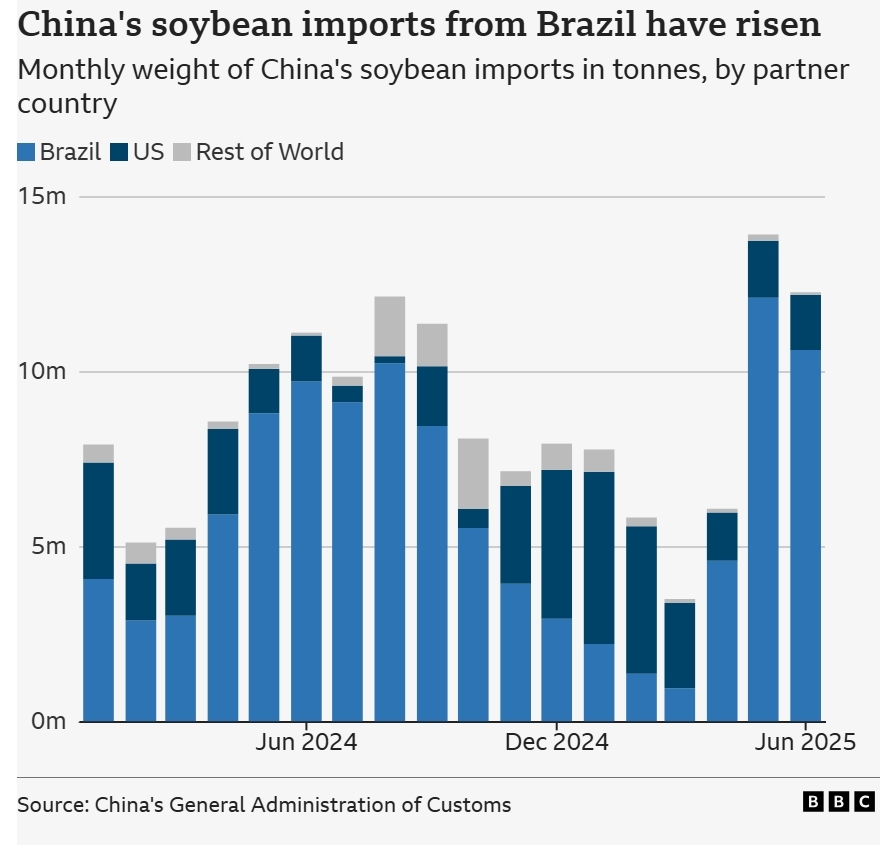
In June 2025 China imported 10.6 million tons of soybeans from Brazil, but only 1.6 million tons from the US.
When China put retaliatory tariffs on US soybean imports in Donald Trump’s first term his administration felt the need to directly compensate US farmers with new subsidies.
US consumer prices are starting to rise
Economists warn that Trump’s tariffs will ultimately push up US prices by making imports more expensive.
The official US inflation rate for June was 2.7%. That was up slightly from the 2.4% inflation figure for May, but still below the 3% rate in January.
Stockpiling in the earlier part of the year has helped retailers absorb the impact of the tariffs without needing to raise retail prices.
However, economists saw in the latest official data some signs that Trump’s tariffs are now starting to feed through to US consumer prices.
Certain imported goods such as major appliances, computers, sports equipment, books and toys showed a marked pick up in prices in June.
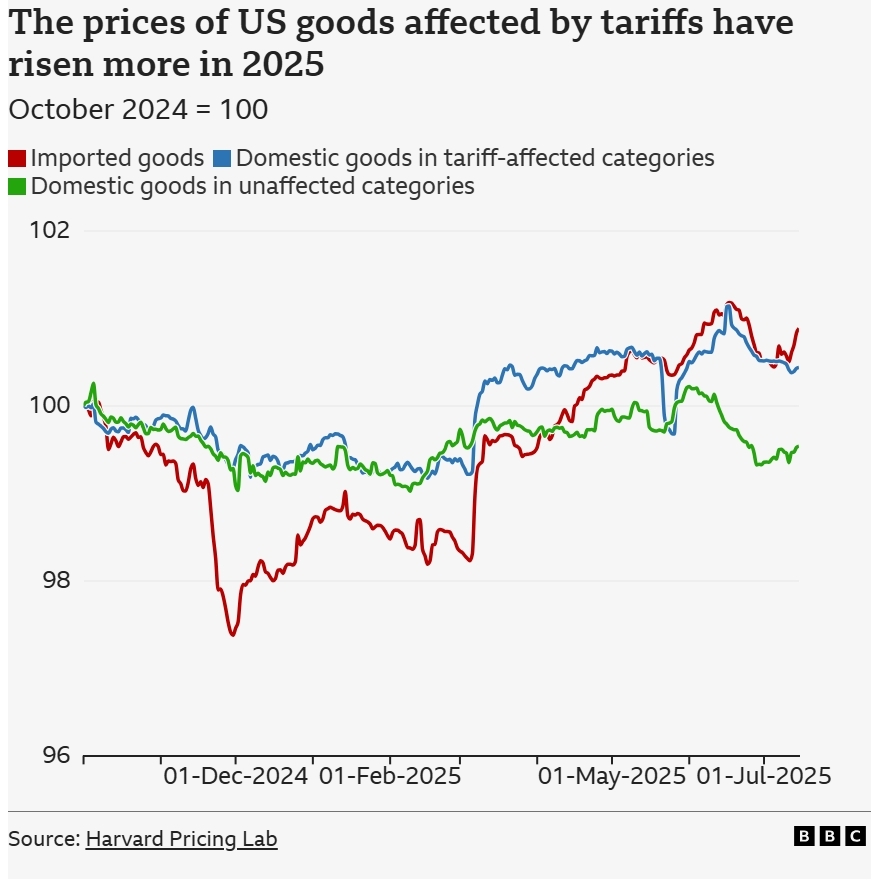
Researchers at Harvard University’s Pricing Lab, who are examining the effects of the 2025 tariff measures in real time using online data from four major US retailers, have found that the price of imported goods into the US and domestic products affected by tariffs have been rising more rapidly in 2025 than domestic goods that are not affected by tariffs.
Rebound in US economic growth in second quarter masks underlying slowing trend
Consumer spending, the engine of the economy, grew moderately after almost stalling in the January-March quarter. Business investment in equipment slowed sharply following double-digit growth in the prior quarter. Residential investment, which includes homebuilding and house sales via brokers’ commissions, contracted for a second straight quarter.
Though the Trump administration has announced a number of trade deals, economists expected tepid growth in the remaining two quarters of this year, arguing the nation’s effective tariff rate was still one of the highest since the 1930s. They noted about 60% of imports remained uncovered by trade agreements.
“The picture is not pretty, an own goal by U.S. policymakers,” said Freya Beamish, chief economist at TS Lombard. “An economy that was purring along, defying expectations of a slowdown, has been placed on hold.”
GDP increased at a 3.0% annualized rate last quarter, the Commerce Department’s Bureau of Economic Analysis said. The economy contracted at a 0.5% pace in the January-March quarter, the first GDP decline in three years.
Economists polled by Reuters had forecast GDP rebounding at a 2.4% annualized rate. The economy grew 1.2% in the first half of the year. Economists expected a lackluster second half, which would limit growth to about 1.5% for the full year. That would be down from 2.8% in 2024 and below the 1.8% rate Federal Reserve policymakers view as the non-inflationary growth pace.
The U.S. central bank on Wednesday left its benchmark interest rate in the 4.25%-4.50% range, resisting pressure from Trump to lower borrowing costs. The Fed acknowledged the slowdown in growth in the first half, and noted that “uncertainty about the economic outlook remains elevated.”
The central bank cut rates three times in 2024, with the last move coming in December. Most economists expect it to resume policy easing in September.
A rush to beat the duties boosted imports in the first quarter, resulting in a record goods trade deficit that weighed on the economy. That reversed last quarter, with imports declining at a record 30.3% rate. The resulting smaller trade deficit added a record 4.99 percentage points to GDP, more than offsetting a 3.17-percentage-point drag from inventories.
Stocks on Wall Street were higher. The dollar gained versus a basket of currencies. U.S. Treasury yields rose.

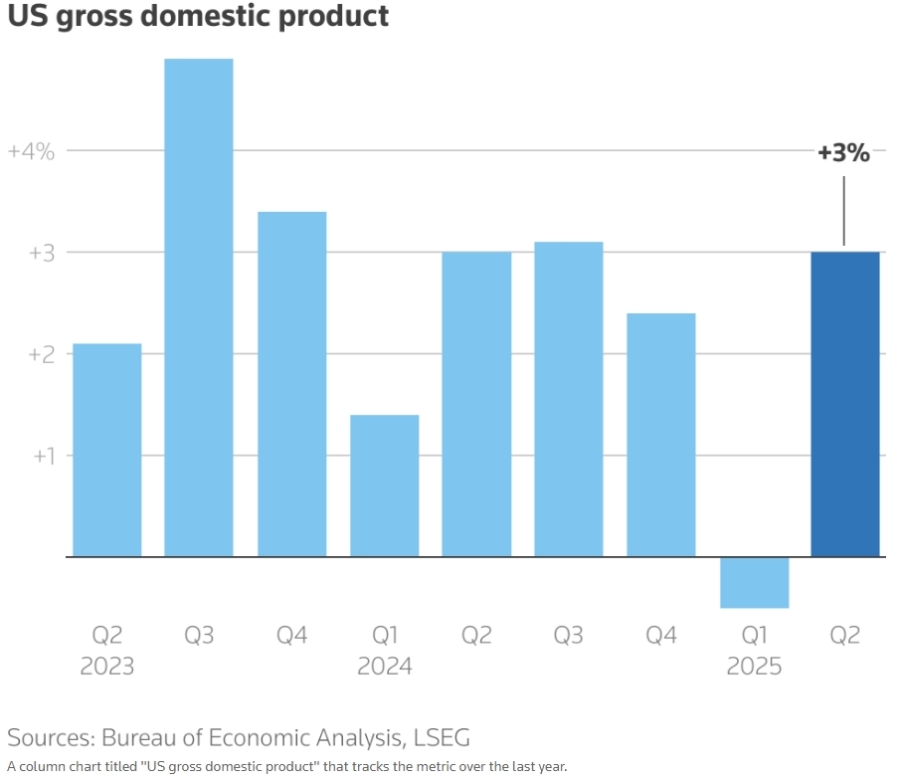
MODERATE CONSUMER SPENDING
With the labor market slowing amid hesitancy by businesses to increase headcount, consumer spending could be sluggish for the remainder of the year. Higher prices from tariffs, which started showing in the June consumer inflation data, could also hamper consumer spending.
Middle- and higher-income households have largely been driving spending. Economists say low-income consumers, already disproportionately affected by higher interest rates and slowing wage growth, would be the hardest hit by tariffs. They also noted the One Big Beautiful Bill’s tax cuts and spending provisions would not benefit lower-income households.
The nonpartisan Congressional Budget Office has estimated the bill will add $3.4 trillion to the nation’s $36.2-trillion debt and only raise inflation-adjusted GDP by an average of 0.5% over 10 years. But pressures are also building up for middle- and higher-income households.

Business spending on equipment grew at a 4.8% rate, slowing from the first quarter’s robust 23.7% pace. Spending on structures such as factories declined for a second straight quarter. Residential investment contracted at a 4.6% rate, the most since the fourth quarter of 2022, amid high mortgage rates.
Reporting by Lucia Mutikani; Editing by Chizu Nomiyama, Andrea Ricci, Rod Nickel
White House Says Liberal Outrage Over Sydney Sweeney’s American Eagle Jeans Commercial Is ‘Moronic’ and a ‘Big Reason Americans’ Voted for Trump
The White House is weighing in on the controversial American Eagle jeans advertisement featuring Sydney Sweeney.
White House communications manager Steven Cheung slammed the Left for its response to the ad, which reads “Sydney Sweeney has great jeans.” The spot plays on “great genes,” which caused some liberal voices to denounce the campaign for glorifying her white heritage and thin physique.
“Cancel culture run amok,” Cheung wrote of the ad on X. “This warped, moronic and dense liberal thinking is a big reason why Americans voted the way they did in 2024. They’re tired of this bullshit.”
In the commercial, Sweeney says, “Genes are passed down from parents to offspring, often determining traits like hair color, personality and even eye color. My jeans are blue.”
Popular on Variety
Conservative TV personality Megyn Kelly also called out the “lunatics on the Left” for their take-down of the ad, calling their reaction “absurd.”
“She’s being called a white supremacist by people who don’t like her latest ad, which is for American Eagle,” she said. “She’s advertising jeans, and yet the lunatics on the Left think she’s advertising white supremacy. This is obviously a reference to her body and not to her skin color, but the lunatic left is going to do what the lunatic left is going to do.”
Kelly added, “They’re upset because it’s about who gets to be the face of America’s Best Genes. They think it’s no accident that they’ve chosen a white, thin woman because you’re, I guess, not allowed to celebrate those things in any way, shape, or form. But they’re completely ignoring the reference to her body, which is the thing she’s famous for. It’s just absurd.”


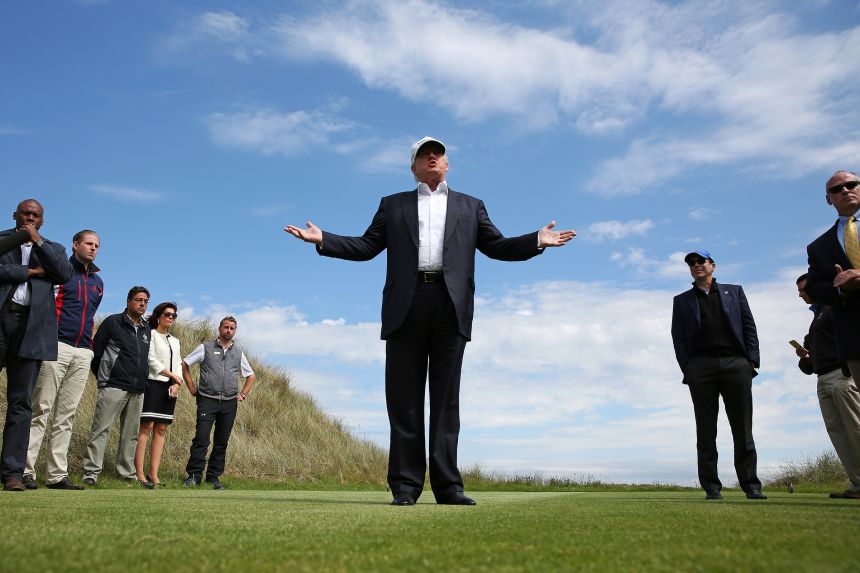




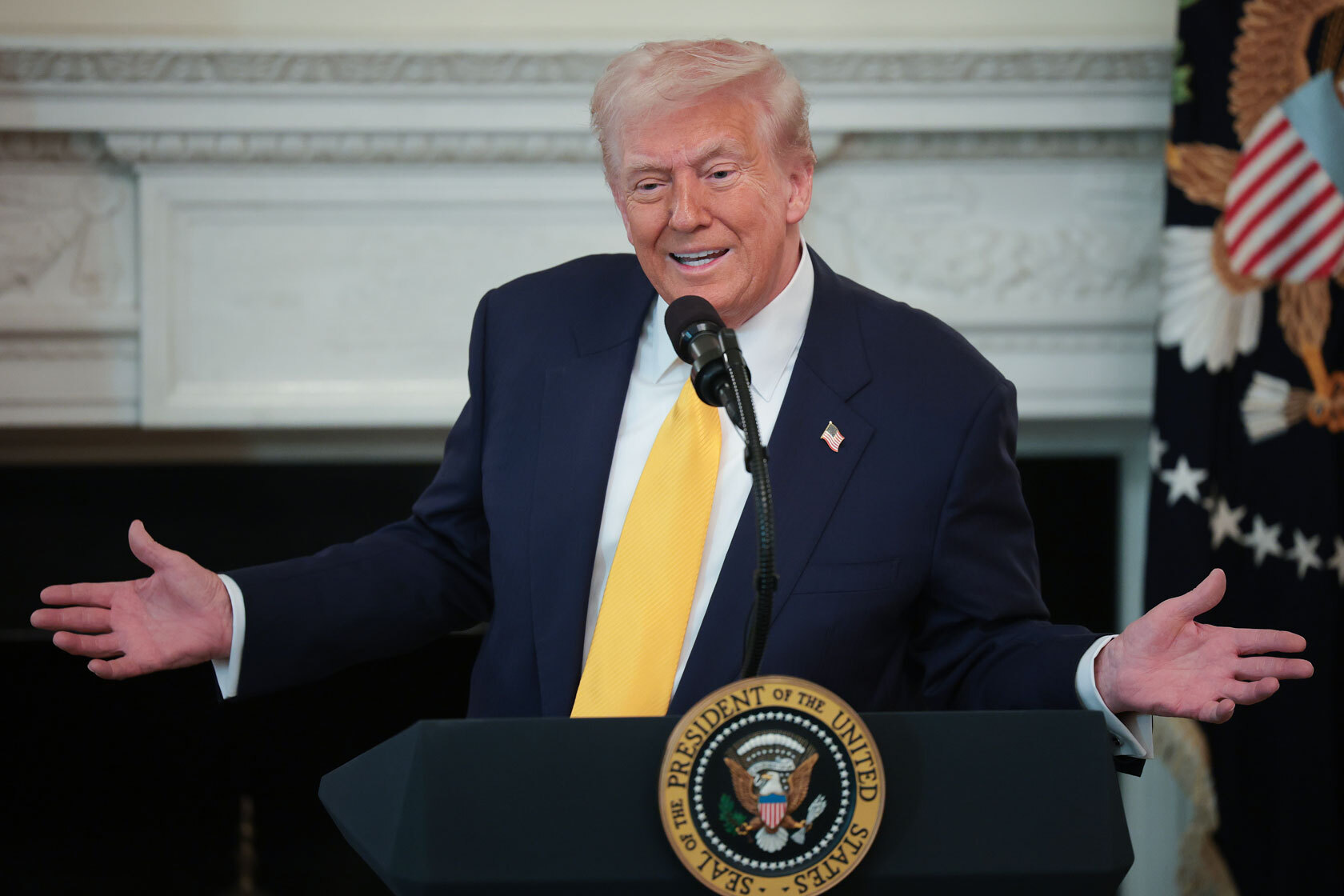
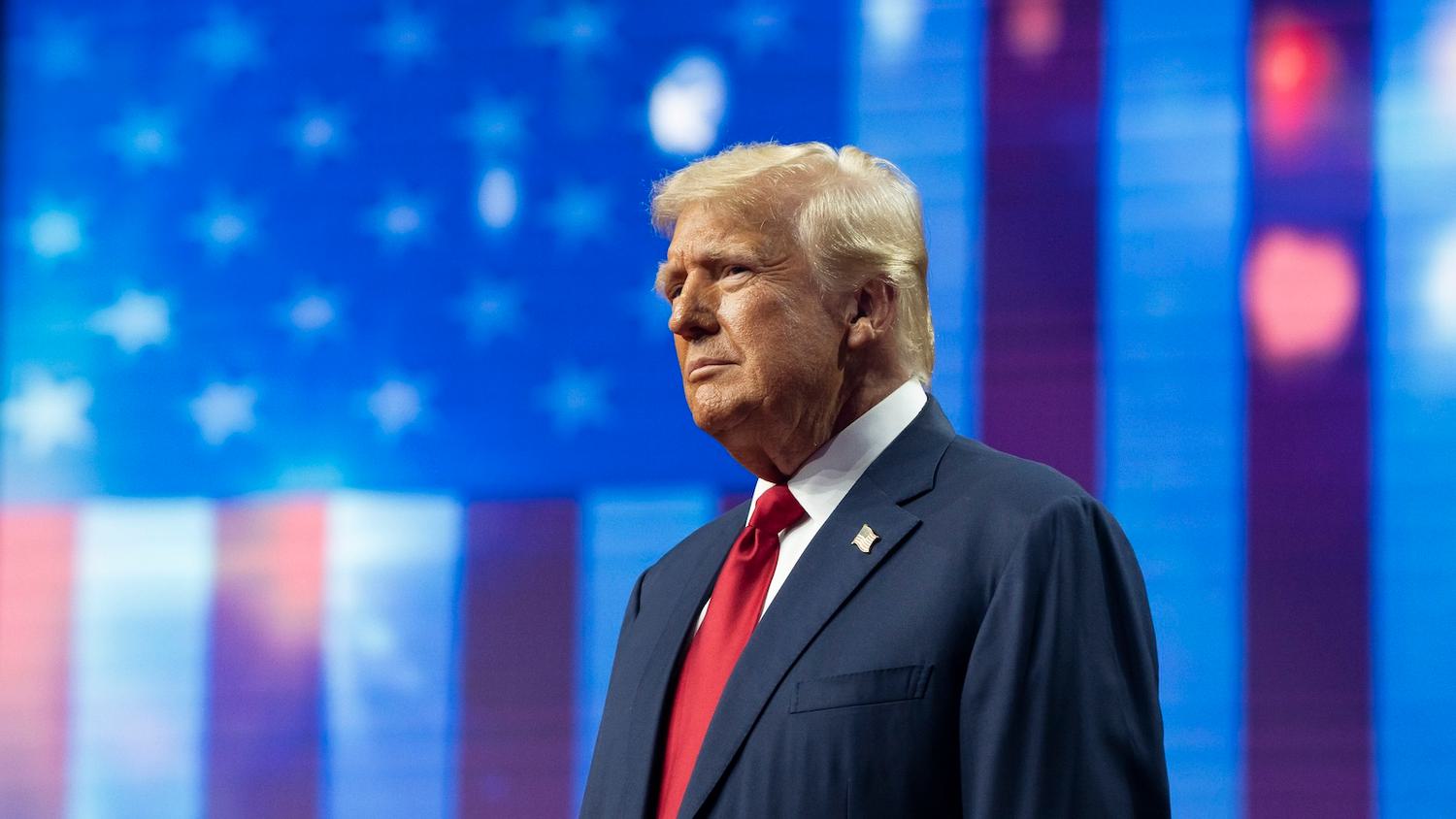
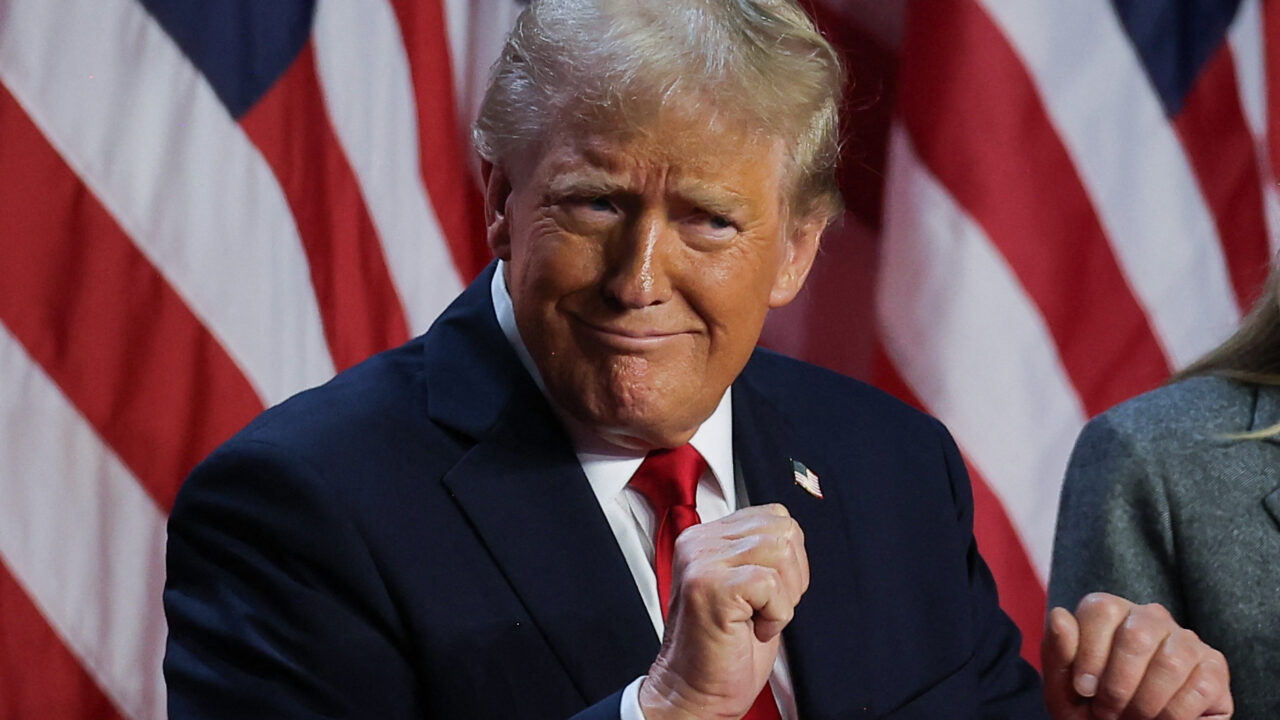
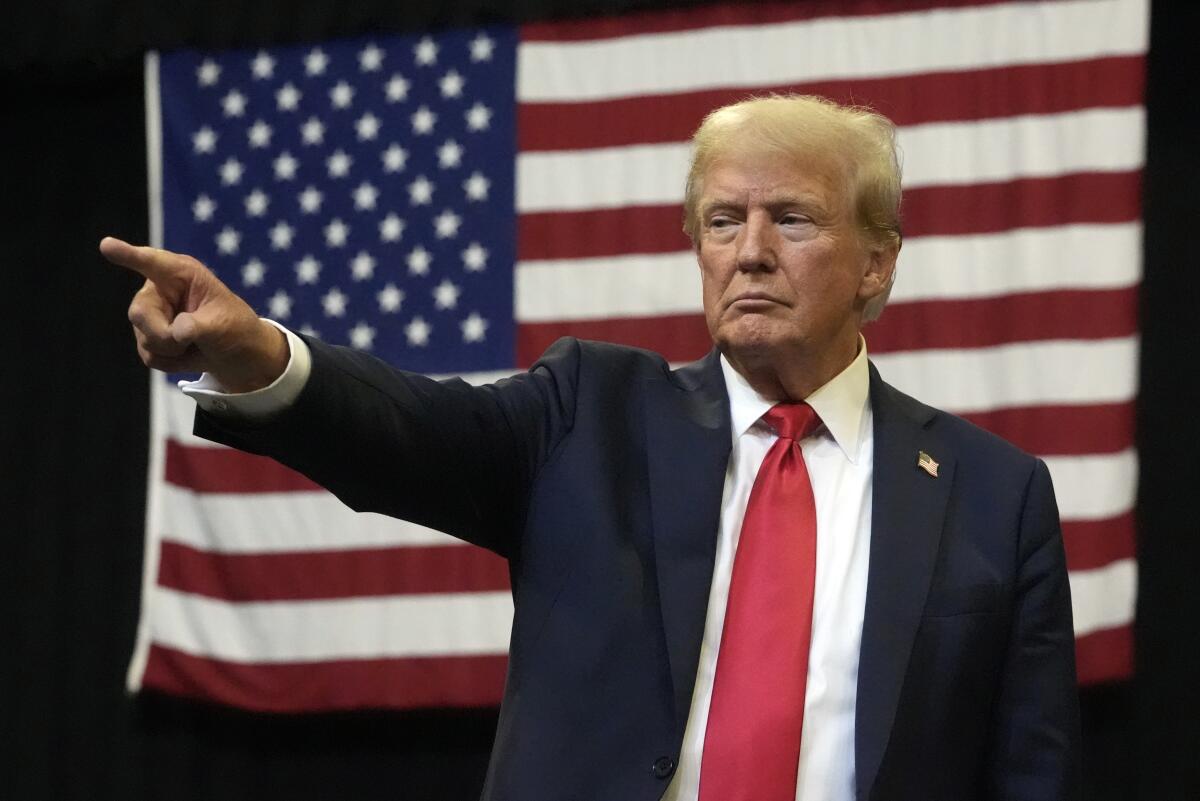

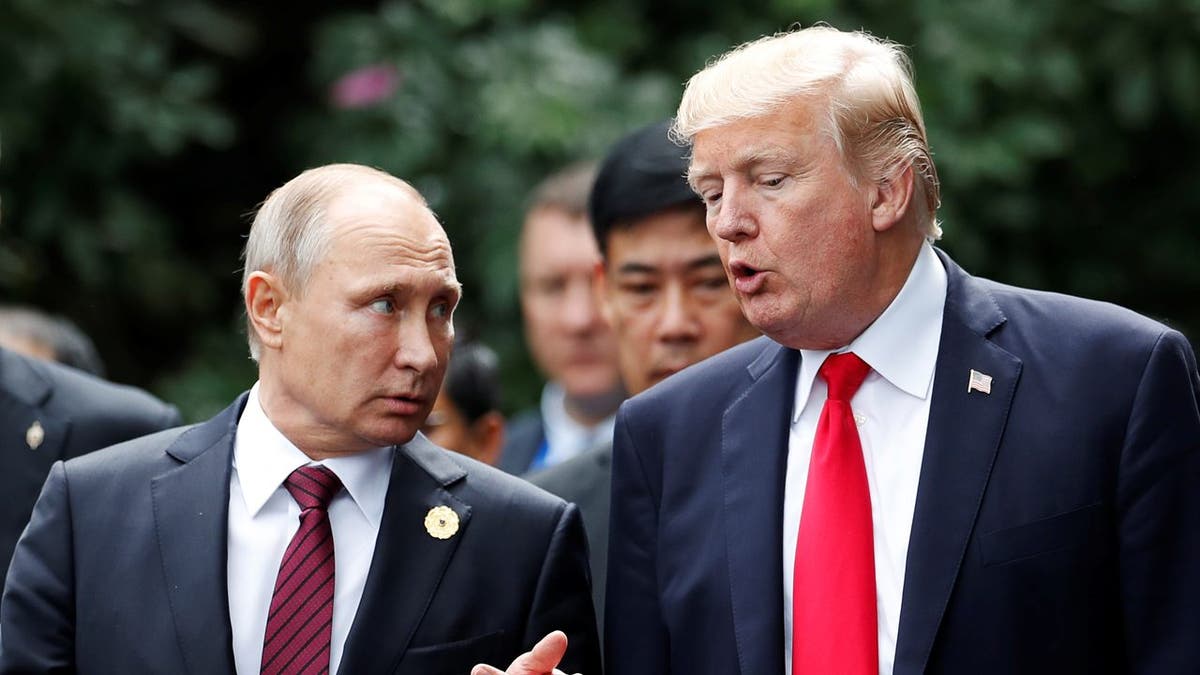


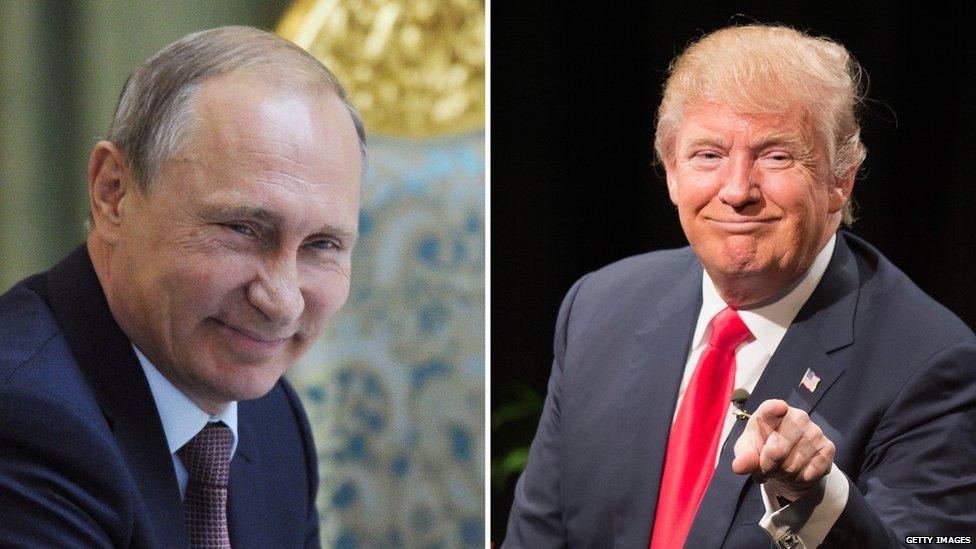























:max_bytes(150000):strip_icc():focal(749x0:751x2):format(webp)/Kia-Thompson-110525-1-770510e2d37345cf861932e5224c360c.jpg?w=1200&resize=1200,0&ssl=1)




















:max_bytes(150000):strip_icc():focal(749x0:751x2):format(webp)/Christianna-Apps-5-121825-ae06cb988405460987109364d7c522c3.jpg?w=1200&resize=1200,0&ssl=1)